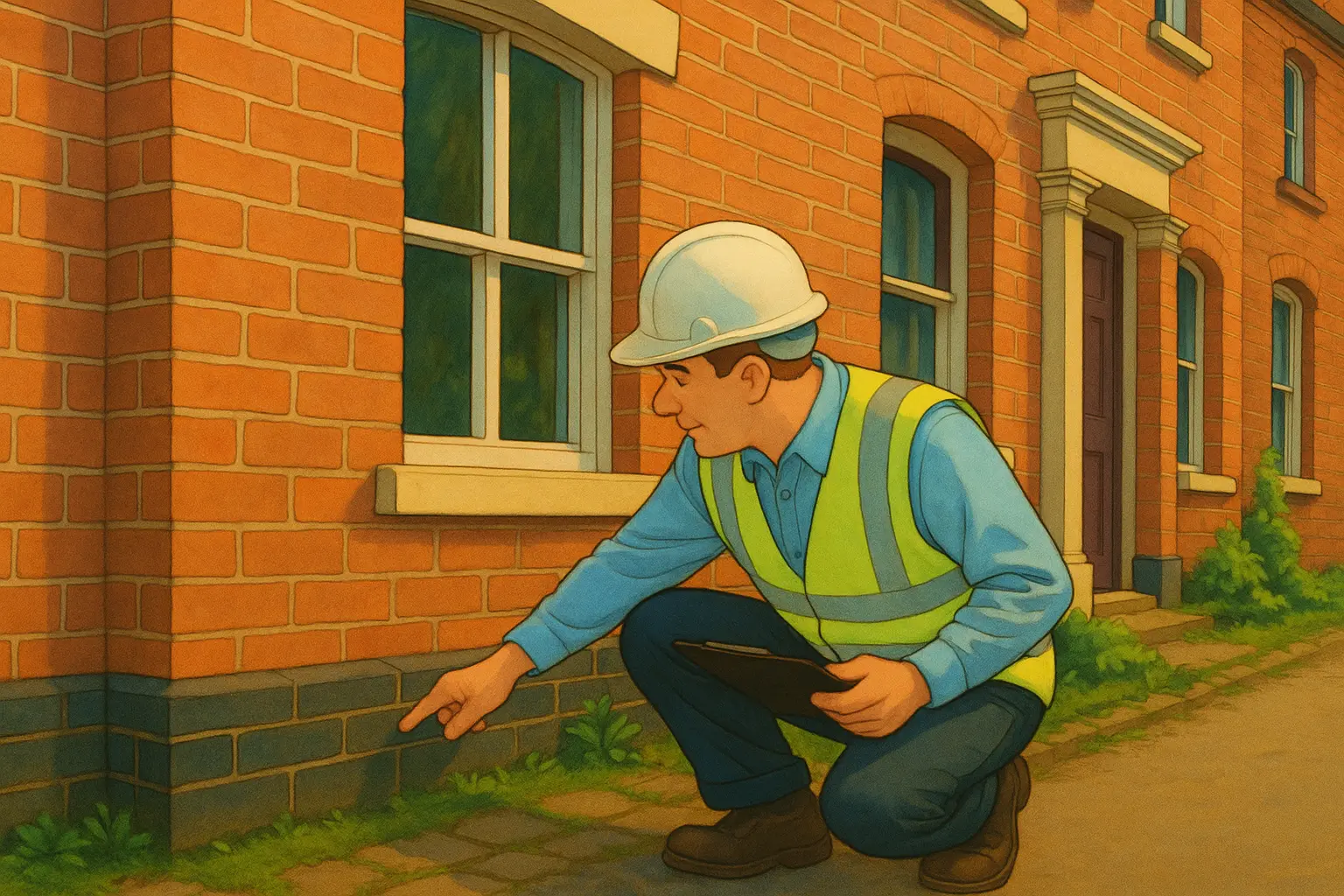Make sure your property is sound with a professional home inspection. Choose the right surveyor to avoid costly surprises.

Building surveyors assess the condition of a property and identify snags, structural issues and other defects. Selecting the right surveyor and survey type are crucial, depending on whether you’re purchasing a new home, renovating, or preparing for a mortgage. This guide will help you navigate your options.
Where can i find a surveyor?
There are several directories and platforms that can connect you with reputable professionals. Make sure that your surveyour is a member of the Royal Institute of Chartered Surveyors.
Bear in mind that your mortgage lender may also offer the option of doing more than a basic survey or they might recommend a specific reputable firm.
The Royal Institute Of Chartered Surveyors

The Royal Institution of Chartered Surveyors is the UK’s main professional body for surveyors. It sets standards, regulates members, and grants chartered status (e.g. MRICS), ensuring surveyors are properly qualified, insured, and act ethically.
The Residential Property Surveyors Association

The Residential Property Surveyors Association (RPSA) is a UK professional body for independent residential surveyors. It sets technical standards, provides training, and ensures members are qualified, insured, and follow a strict code of conduct. RPSA surveyors specialise in residential properties and offer clear, consumer-friendly reports.
Really Moving

ReallyMoving helps people with their home move. Register on their website to get quotes for conveyancing, property surveys, an home moving. When you request a quote for a survey, they will take your details, match you with up to 4 surveyors and pass your contact details to these surveyors. The surveyors will then contact you with quotes (via email and/or telephone)
Co-ordinate with your lender
If you are applying for a mortgage, your lender will require a home inspection or valuation survey as part of the mortgage approval process. Here are some steps to help you align with your lender’s requirements:
Understand the lender’s requirements
Mortgage lenders usually conduct a valuation survey to confirm the property’s value (sometimes they do this free of charge, sometimes not). Their survey usually do not cover structural issues – very often it just means a qualified surveyor will drive past the property or do a fairly superficial assessment without entering the property.
Clarify this with your lender, and ask them if they recommend a more comprehensive survey, and whether the lender’s survey and your own survey can be combined into a single survey.
Get your lender’s approval
Some lenders only accept surveys from RICS-accredited surveyors or specific firms. Be sure to confirm that your chosen surveyor is approved by your lender to avoid any delays or additional expenses.
Requesting your own home inspection – your options
There are different types of home inspections or building surveys, each with a specific purpose. The Royal Instiute of Chartered Surveyors (RICS) have formally defined three levels, the full details of which you can find here.
Here is a summary of the most common types to help you determine which is best for your situation:
Mortgage valuation
This is a basic survey to enable the lender to confirm the property’s value. The only thing a lender is really interested in is to ensure that the value of the property is higher than the value of the loan. It is not intended to reveal structural issues but if the property is in an obviously poor state this will be raised in the report.
Condition report (RICS Level 1)
This is the simplest and cheapest type of home inspection you can commission. It provides an overview of the property’s condition without going into detail. The surveyor will visit the property and do a fairly superficial visual inspection of the outside and the inside, and highlight clearly visible issues in their report (without going into any details).
It is more suitable for newer properties or homes that are clearly in good condition.
Homebuyer report (RICS Level 2)
This is a mid-level survey that includes more details about structural elements. The surveyor will do a more thorough investigation of the whole property inside and outside, including roof spaces and basements if these are accessible.
This type of home inspection should identify issues like damp, subsidence, roof problems, wood rot, insulation, and drainage, and it may suggest how to address these issues (check with your chosen surveyor if this will be included).
It could aslo include a valuation – both a market value and an insurance rebuild cost (check with your chosen surveyor).
Building survey (full structural survey RIS Level 3)
This is the most detailed (and expensive) survey you can commission. The surveyor will do a very thorough inspection of all accessible parts of the property: inside, outside, loft, roof, under floors, walls, and more.
This type of home inspection will identify any defects, including structural issues, damp, woodworm, rot, roof problems, and anything unusual. But it will go further than just spotting the problems, and explain the likely causes of the problem, as well as recommended fixes.
They should include detailed advice on repairs, timescales, and potential costs. A full structural survey normally does not include a valuation but please confirm with you chosen surveyor.
Snagging survey
A home inspection for newly built properties. This checks for incomplete or substandard work, identifying any issues that need to be fixed by the developer. It is designed specifically for new-build properties.
What type of home inspection is right for my property?
| Property Type | Recommended Survey |
|---|---|
| A brand new house | Snagging Survey (or skip if NHBC cover) |
| A fairly new house visually in a good condition | Condition Report or Homebuyer Report |
| A modern house visually in a poor condition | Homebuyer Report (or Full Building Survey if severe) |
| A mid-20th century house visually in a good condition | Condition Report or Homebuyer Report |
| A mid-20th century house visually in a poor condition | Full Building Survey |
| An early 20th century or older house | Full Building Survey |
| A purpose-built flat in an old apartment block | Homebuyer Report |
| A purpose-built flat in a modern apartment block | Condition Report or Homebuyer Report |
| A recently converted flat in an old building | Full Building Survey |
| A recently converted flat in a modern building | Condition Report or Homebuyer Report |
| An old flat conversion | Full Building Survey |
How much will it cost?
It is quite diffult to provide accurate cost estimates for home inspections, as the cost will vary based on factors such as the property’s size, value, age, condition, and location.
For instance, larger or older properties, or those in areas like London, will incur higher survey costs.
Your best bet is to obtain quotes from several RICS-accredited surveyors to get an accurate estimate for your specific property – the next section contains links to websites where you can get quotes.
Here is a very rough idea of how much it may cost
| Home Condition Report (RICS Level 1) | £300 to £900 |
| Home Buyers Report (RICS Level 2) | £400 to £1,500 |
| Full Building Survey | £600 to £1,500 ++ |
Tips on choosing a surveyor
Choosing the right surveyor is essential to getting an accurate and thorough assessment of the property. Consider the following :
Qualifications and accreditations
Choose a surveyor who is accredited by RICS or a similar regulatory body to ensure they adhere to professional standards.
Specialisation
Some surveyors specialise in specific property types, such as historical buildings, high-rise flats, or new builds. Select a surveyor with experience relevant to the property you’re having evaluated.
Clear reporting
Ensure that your surveyor provides clear, detailed reports. Sample reports can often be requested upfront so you can review the format and level of detail they offer.
Cost transparency
Request a detailed quote upfront, including any potential extra charges for additional work or travel expenses.
Reviews and recommendations
Read reviews and ask for recommendations. Previous clients can give insight into the surveyor’s thoroughness, reliability, and communication style. This is especially relevant if you want an in-depth survey.
By using these resources and considering the specific requirements for your purchase, you can select a qualified building surveyor who will provide valuable insights into your property’s condition. This can aid you with your purchasing decision and give you peace of mind.
